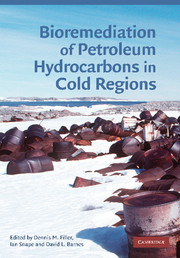Book contents
- Frontmatter
- Contents
- List of contributors
- Preface
- Glossary
- 1 Contamination, regulation, and remediation: an introduction to bioremediation of petroleum hydrocarbons in cold regions
- 2 Freezing and frozen soils
- 3 Movement of petroleum through freezing and frozen soils
- 4 Hydrocarbon-degrading bacteria in contaminated cold soils
- 5 Temperature effects on biodegradation of petroleum contaminants in cold soils
- 6 Analytical methods for petroleum in cold region soils
- 7 Treatability studies: microcosms, mesocosms, and field trials
- 8 Nutrient requirements for bioremediation
- 9 Landfarming
- 10 Thermally enhanced bioremediation and integrated systems
- 11 Emerging technologies
- References
- Index
5 - Temperature effects on biodegradation of petroleum contaminants in cold soils
Published online by Cambridge University Press: 22 August 2009
- Frontmatter
- Contents
- List of contributors
- Preface
- Glossary
- 1 Contamination, regulation, and remediation: an introduction to bioremediation of petroleum hydrocarbons in cold regions
- 2 Freezing and frozen soils
- 3 Movement of petroleum through freezing and frozen soils
- 4 Hydrocarbon-degrading bacteria in contaminated cold soils
- 5 Temperature effects on biodegradation of petroleum contaminants in cold soils
- 6 Analytical methods for petroleum in cold region soils
- 7 Treatability studies: microcosms, mesocosms, and field trials
- 8 Nutrient requirements for bioremediation
- 9 Landfarming
- 10 Thermally enhanced bioremediation and integrated systems
- 11 Emerging technologies
- References
- Index
Summary
Introduction
Bioremediation in cold climates is frequently regarded with skepticism. Owners of polluted sites and regulatory agencies may doubt the effectiveness of biological degradation at near freezing temperatures. While it is true that biodegradation rates decrease with decreasing temperatures, this does not mean that bioremediation is inappropriate for cold regions. Microbial degradation of hydrocarbons occurs even around 0 °C (Chapter 4). In remote alpine, Arctic, and Antarctic locations, excavation and shipping of contaminated soil may be prohibitively expensive. Bioremediation may be the most cost-effective alternative. This chapter discusses microbial adaptation to cold temperatures as well as results of laboratory and field studies of bioremediation at low temperatures.
Microorganisms can grow at temperatures ranging from subzero to more than 100 °C. Microbes are divided into four groups based on the range of temperature at which they can grow. The psychrophiles grows at temperatures below 20 °C, the mesophiles between 20 °C and 44 °C, the thermophiles between 45 °C and 70 °C, and the hyperthermophiles require growth temperatures above 70 °C to over 110 °C. The term “cold-adapted microorganisms” (CAMs) is frequently used for describing bacteria growing at or close to zero degrees Celsius. Depending on the cardinal temperatures (the minimal, the optimal, and the maximum growth temperature), CAMs can be classified as psychrophiles or psychrotrophs. Morita's (1975) definition, which holds that psychrophiles have a maximum growth temperature of less than 20 °C and an optimal growth temperature of less than 15 °C, while psychrotrophs have a maximum temperature of 40 °C and an optimal growth temperature higher than 15 °C, is widely accepted.
- Type
- Chapter
- Information
- Bioremediation of Petroleum Hydrocarbons in Cold Regions , pp. 84 - 108Publisher: Cambridge University PressPrint publication year: 2008
- 7
- Cited by

